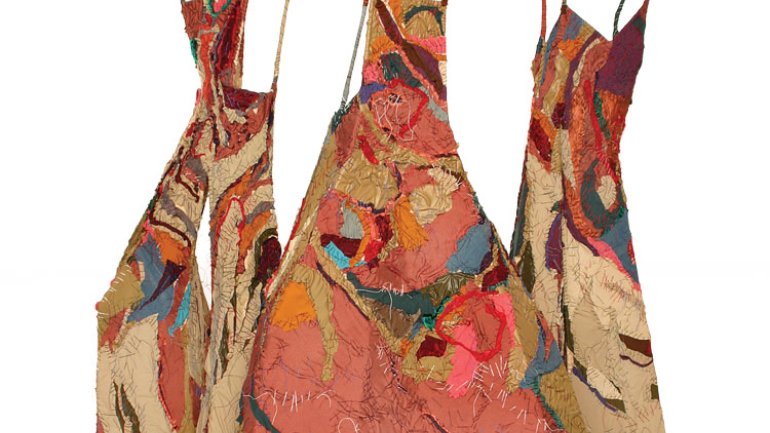Reclaims of the Day
Reclaims of the Day
Marilyn Annin's sculptures have a ghostly presence. Each inhabits a garment with the sort of detail and texture associated with robes worn by medieval royalty, yet the figures are empty, disembodied. Take a few steps closer, and you may be startled to find the source of all this grandeur: trash. Well, not trash, exactly, but the flotsam and jetsam of a consumer society, the treasured finds of the magpie, the stray buttons from the button jar, the scraps of fabric in useless shapes too pretty to throw away.
From the thousands of things we flick away in their weightlessness, Annin composes garments so weighty they could never be worn by a human being.
The materials she uses are a critical part of the message, as well as an aesthetic choice. "The only materials I buy at retail are the steel, and the acetylene and oxygen for my torch," Annin says. In her studio in the lake country of northern Wisconsin, she uses those provisions to weld the armatures that support the garments. The rest of her supplies come from an enormous collection of flea-market treasures amassed over more than 10 years, as well as found objects, recyclables, thread, twine, fabric, and wire, which she stores in large transparent boxes sorted by kind. Each tiny piece brings its own story to the sculpture it adorns.
One of her favorite supplies is the aluminum can tab. "That can tab represents, in my view, the perfect package. That represents our culture." For Dining In (1992), she created a robe fit for an American king, with sumptuous patterning formed of can tabs and smashed beer bottle caps. In Striving for Perfection (1990), can tabs, safety pins, and house numbers meld together to form the fabric of a swinging silver party gown with metal boning. The effect initially suggests a woman celebrating, but the numbers and unraveling wire at the hem hint at a woman frantically moving within a cage that barely contains her over-quantified life.
Garden twine, white buttons, and red and blue string make up Think Nothing of It (2004), a dress that seems composed entirely of dutiful repairs. Most recently, Wedding Frock: Passing Fancy (2011) fashions six-pack rings, eyelet tape, wire, and shreds of old lace into a commentary on love and permanence.
Born in Madison, Wisconsin, in 1938, Annin has spent about equal parts of her life in Wisconsin, Minnesota, and Iowa. A painter for many years, with a degree in art education from the University of Wisconsin-Madison, she says she "backed into" sculpture. When she was nearing 40, she took painting courses at the Minnetonka Center for the Arts near Minneapolis. An instructor asked her to help recruit painters to fill a sculpture class.
It wasn't easy to coax painters to cross over to the 3D world. She succeeded, but had no interest in taking the class herself. Annin laughs as she recalls the reaction of the instructor: "You've got to be kidding. You go in there and get yourself a welding station!"
To her amazement, Annin fell in love with sculpture. Working in three dimensions, she saw the magic of placement in space. The process launched her back into childhood days spent arranging toys in tree houses and imaginary spaces.
It's in that spirit of play that she arranges objects from her collection, listening to her materials as she creates surprising mosaics of texture, color, and story. Neckties form rainbow-hued muscles, while sandbags and bits of costume jewelry transmute into regal gowns. The mundane castoffs of daily existence regroup, urging, "Try me on."
Rachel Schalet Crabb is a writer and fiber artist in Minneapolis.

